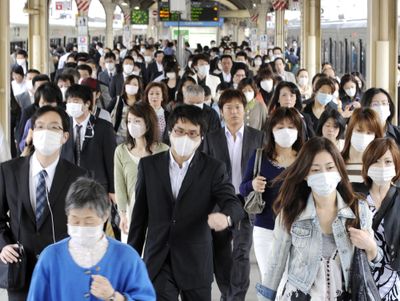Merits of swine flu alert debated
Some fear warnings will lead to panic

As the World Health Organization inched closer Monday to raising the infectious disease alert level to its highest stage – and to a decision on whether to manufacture a vaccine against the H1N1 influenza virus – some delegates to the WHO congress in Geneva urged the agency to change its criteria for increasing the alert level.
Current rules call for the alert to be raised to Phase 6 if community transmission of the new virus is observed in two WHO regions. So far, such transmission has been observed only in North America, which accounts for about 95 percent of the nearly 9,000 confirmed infections that have been observed.
But an outbreak of the virus in Japan detected over the weekend hints that such transmission soon might be observed in Asia as well. Japanese authorities said Monday in Tokyo that there have been 135 confirmed cases of H1N1 influenza in schools in Kobe and Osaka, mostly among students and their family members who have not visited North America, suggesting that the virus might have been transmitted locally. Authorities have ordered more than 1,000 schools in those cities closed.
Other pockets of infection have been observed in Spain, with 103 confirmed infections, and Britain, with 82. The WHO has been monitoring the situation closely in all three countries, but so far “we don’t see sustained community spread,” a spokesman said.
Several cases also have been observed in South America, and officials are keeping an eye there as well because that hemisphere is just now entering its flu season, providing fertile ground for the virus to spread.
Governments in many countries, including China, Japan and Britain, fear that raising the alert level will put more pressure on their health systems, impede international travel and cause outbreaks of panic even though the new strain of virus appears to be no more lethal than seasonal flu.
But WHO officials noted that severity will be different in different countries, making it difficult to agree on an objective measure of the virus’s effects. Transmission, however, provides a clear, objective measure of viral spread.
The criteria, moreover, were set largely in response to the avian flu virus, which is much more lethal than H1N1 but not readily transmissible among humans.
Dr. Margaret Chan, WHO director-general, will meet with vaccine manufacturers today to talk about their preparedness to manufacture a vaccine against the new virus. The agency is expected to make a decision this week about whether to produce such a vaccine.
A key factor in the decision might be whether the manufacturers also will be able to produce a seasonal flu vaccine.
For logistical reasons, it would be extremely difficult to make the two at the same time or to combine them into one vaccine.